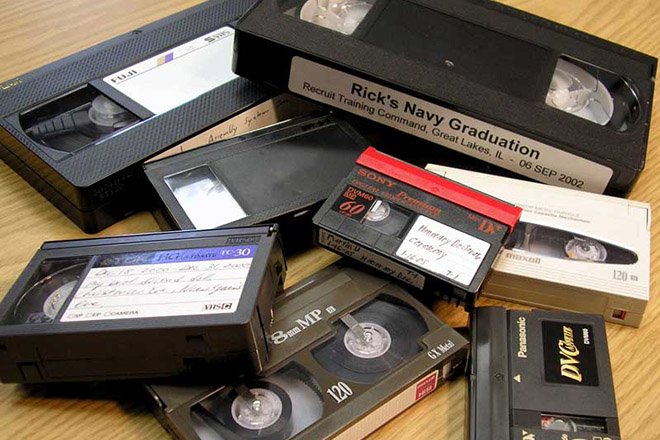Convert Tapes to Digital – Preserve Your Precious Family Memories Before They Disappear

In the age of smartphones and cloud storage, most people no longer rely on physical tapes to store precious memories. However, millions of families around the world still have boxes of VHS, MiniDV, Hi8, or camcorder tapes tucked away in closets and basements. These tapes hold priceless moments—childhood birthdays, weddings, family trips, and more—but they are quietly deteriorating over time. Converting tapes to digital is no longer just a convenience—it’s a race against time to preserve your family history before it’s gone forever.
Why You Should Convert Your Tapes to Digital
Magnetic tapes, like VHS and camcorder cassettes, were never meant to last forever. The average lifespan of a videotape is around 15 to 25 years under ideal storage conditions. Unfortunately, most tapes aren’t stored in temperature-controlled environments, and over time, several issues begin to appear.
Tape Deterioration
Magnetic tape is made of materials that degrade naturally. The magnetic particles that store video and audio signals can lose their charge, causing static, flickering images, or even complete data loss. Dust, mold, and humidity can also eat away at the tape, making playback impossible.
Equipment Obsolescence
Even if your tapes are still in decent shape, finding a working VCR or camcorder can be extremely difficult. Manufacturers stopped making VCRs years ago, and old playback devices are breaking down or becoming expensive collector’s items. Without the proper equipment, your home movies remain locked in an unwatchable format.
Convenience and Accessibility
When you convert your tapes to digital, you make it easy to watch and share your videos on modern devices. Instead of digging through boxes and connecting outdated players, you can access your videos instantly on your phone, computer, or TV. Digital files can also be easily backed up, shared online, or edited into highlight reels for family gatherings.
Understanding the Conversion Process
Converting tapes to digital may sound complicated, but the process is straightforward once you understand the steps involved. You can either do it yourself using conversion hardware or hire a professional service to handle everything for you.
Step 1: Gather and Inspect Your Tapes
Before starting, collect all your tapes and check their condition. Label them clearly with the event or date if possible. Look for visible damage such as cracks, mold, or tangled reels. If a tape is extremely fragile, avoid playing it until a professional evaluates it.
Step 2: Choose the Right Equipment
If you decide on a DIY approach, you’ll need:
- A working VCR or camcorder compatible with your tape format
- A video capture device (USB or external converter)
- A computer with video capture software
Connect the playback device to your computer using RCA or S-Video cables, then use the capture software to record the footage in real-time. This means a two-hour tape will take two hours to digitize.
Step 3: Select Output Formats
Most people choose common digital formats like MP4 or MOV, which are compatible with nearly all devices and easy to edit or share. Aim for a balance between video quality and file size. HD quality is ideal if the footage supports it, but standard definition often works fine for older recordings.
Step 4: Edit and Enhance the Video
Once your footage is digitized, you can enhance it using video editing software. Adjust brightness, color, and sound to improve the viewing experience. You can also cut unwanted sections, add titles, or create a highlight reel of your favorite moments.
Step 5: Store and Back Up
After converting your tapes to digital, proper storage is key. Save copies of your videos on multiple platforms—external hard drives, USB drives, and cloud storage services like Google Drive or Dropbox. Having backups ensures that your memories are safe even if one storage device fails.
Professional Conversion Services
For those who prefer a hassle-free experience, professional tape conversion services are an excellent option. These companies have specialized equipment that can handle various tape formats and restore footage from damaged or aged tapes. Many services also include video enhancement, color correction, and noise reduction.
When choosing a service, look for:
- Experience with different tape formats (VHS, Betamax, MiniDV, Hi8, etc.)
- High-quality digital outputs
- Secure handling of your personal footage
- Options for cloud delivery or USB/hard drive storage
Professional conversion may cost more than doing it yourself, but the peace of mind and quality results are often worth it.
The Urgency of Preserving Family Memories
It’s easy to postpone converting old tapes, thinking they’ll last another few years. But the reality is that every year of delay increases the risk of permanent loss. Temperature fluctuations, humidity, and oxidation gradually destroy the magnetic surface of tapes. In some cases, even the plastic casing can warp or crack over time.
The memories captured on these tapes are irreplaceable—your child’s first steps, grandparents’ laughter, and family celebrations that can never be recreated. By converting tapes to digital now, you ensure that these moments remain part of your family’s legacy for generations.
Benefits of Digital Preservation
Longevity
Digital files don’t degrade with time the way tapes do. As long as you back them up and maintain your storage, they can last indefinitely.
Easy Sharing
Once your videos are digital, sharing them with family and friends around the world takes just a few clicks. You can upload them to private YouTube channels, family drives, or social media.
Space Saving
Boxes of bulky tapes take up valuable storage space. Digitized versions can be stored on a single USB drive or in cloud storage, freeing up physical space in your home.
Future-Proofing
Technology keeps evolving, but digital files can easily be migrated to newer formats and devices. Unlike tapes, they won’t become obsolete as long as you keep them updated.
Common Mistakes to Avoid
When converting tapes to digital, there are a few pitfalls to watch out for:
- Neglecting tape cleaning: Dirty or dusty tapes can cause playback issues or damage your VCR heads.
- Low-quality converters: Cheap video capture devices often produce blurry or distorted results.
- Single backup: Always store copies in more than one place.
- Improper file naming: Label each video clearly to avoid confusion later.
A little extra care during conversion can save you frustration in the future.
The Emotional Reward
Beyond the technical aspects, there’s a deep emotional value in reliving old family videos. Seeing long-forgotten faces and moments can reconnect families and bring joy to future generations. Converting tapes to digital is not just a technical process—it’s an act of love and preservation.
Final Thoughts
Your old videotapes hold the heart of your family’s story. Time, unfortunately, is their greatest enemy. Don’t wait until the day your VCR no longer works or your tapes turn to static. Take the step now to convert your tapes to digital, and ensure that your memories live on—in vibrant, accessible formats that can be enjoyed for decades to come.







